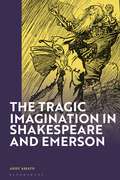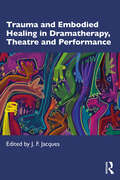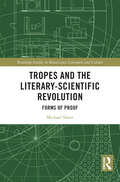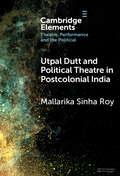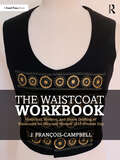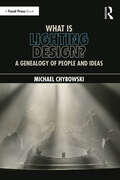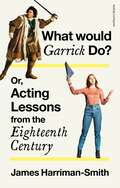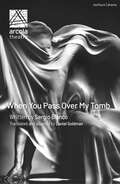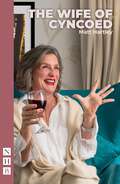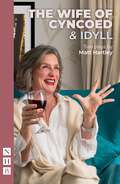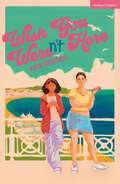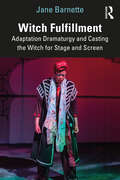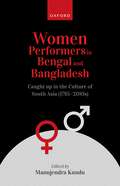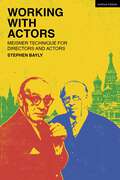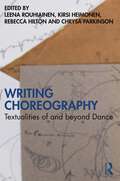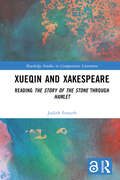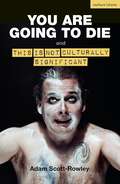- Table View
- List View
The Tragic Imagination in Shakespeare and Emerson
by Andy AmatoWhat is the “tragic imagination”? And what role does it play in the works of William Shakespeare and Ralph Waldo Emerson? Explaining the tragic imagination as a creative faculty employed to answer the perennial Riddle of the Sphinx – a theory of the world that advances human freedom and dignity in the face of historical injustice, cruelty and violence – Andy Amato seeks to recover and rehabilitate this concept by revealing its significance to both key works of philosophy and literature and our contemporary world. This book begins with a close and careful reading of Emerson's first major work, Nature, in conversation with nineteenth and 20thcentury continental philosophy, critical theory and post-structuralism. Uncovering neglected elements of Emerson's philosophy, beyond his reputation as the philosopher of 'cheer', this book explores how Emersonian transcendentalism affirms rather than denies the tragic sense of life – “tragic idealism” – and makes a substantial contribution to philosophy's perpetual endeavour to solve the Riddle. In the second part of the book, Amato then employs Emerson's theoretical lens to interpret Shakespeare's tragedy, King Lear. In doing so, he innovatively reframes the central themes of suffering, vision, nature, nothing, foolishness and silence toward achieving liberation.By pairing these two giants of literature and philosophy, The Tragic Imagination in Shakespeare and Emerson not only offers fresh interpretations of Nature and King Lear, but also makes the case for the renewed deployment of tragic imagination, in creative redress, to our current social-political situation.
Trauma and Embodied Healing in Dramatherapy, Theatre and Performance
by J. F. JacquesThis edited volume explores the singularity of embodiment and somatic approaches in the healing of trauma from a dramatherapy, theatre and performance perspective.Collating voices from across the fields of dramatherapy, theatre and performance, this book examines how different interdisciplinary and intercultural approaches offer unique and unexplored perspectives on the body as a medium for the exploration, expression and resolution of chronic, acute and complex trauma as well as collective and intergenerational trauma. The diverse chapters highlight how the intersection between dramatherapy and body-based approaches in theatre and performance offers additional opportunities to explore and understand the creative, expressive and imaginative capacity of the body, and its application to the healing of trauma.The book will be of particular interest to dramatherapists and other creative and expressive arts therapists. It will also appeal to counsellors, psychotherapists, psychologists and theatre scholars.
Trauma and Embodied Healing in Dramatherapy, Theatre and Performance
This edited volume explores the singularity of embodiment and somatic approaches in the healing of trauma from a dramatherapy, theatre and performance perspective.Collating voices from across the fields of dramatherapy, theatre and performance, this book examines how different interdisciplinary and intercultural approaches offer unique and unexplored perspectives on the body as a medium for the exploration, expression and resolution of chronic, acute and complex trauma as well as collective and intergenerational trauma. The diverse chapters highlight how the intersection between dramatherapy and body-based approaches in theatre and performance offers additional opportunities to explore and understand the creative, expressive and imaginative capacity of the body, and its application to the healing of trauma.The book will be of particular interest to dramatherapists and other creative and expressive arts therapists. It will also appeal to counsellors, psychotherapists, psychologists and theatre scholars.
Tropes and the Literary-Scientific Revolution: Forms of Proof (Routledge Studies in Renaissance Literature and Culture)
by Michael SlaterTropes and the Literary-Scientific Revolution: Forms of Proof argues that the rise of mechanical science in the seventeenth century had a profound impact on both language and literature. To the extent that new ideas about things were accompanied by new attitudes toward words, what we commonly regard as the “scientific revolution” inevitably bore literary dimensions as well. Literary tropes and forms underwent tremendous reassessment in the seventeenth century, and early modern science was shaped just as powerfully by contest over the place of literary figures, from personification and metaphor to anamorphosis and allegory. In their rejection of teleological explanations of natural motion, for instance, early modern philosophers often disputed the value of personification, a figural projection of interiority onto what was becoming increasingly a mechanical world. And allegory—a dominant mode of literature from the late Middle Ages until well into the Renaissance—became “the vice of those times,” as Thomas Rymer described it in 1674. This book shows that its acute devaluation was possible only in conjunction with a distinctively modern physics. Analyzing writings by Sidney, Shakespeare, Bacon, Jonson, Brahe, Kepler, Galileo, Hobbes, Descartes, and more, it asserts that the scientific revolution was a literary phenomenon, just as the literary revolution was also a scientific one.
Tropes and the Literary-Scientific Revolution: Forms of Proof (Routledge Studies in Renaissance Literature and Culture)
by Michael SlaterTropes and the Literary-Scientific Revolution: Forms of Proof argues that the rise of mechanical science in the seventeenth century had a profound impact on both language and literature. To the extent that new ideas about things were accompanied by new attitudes toward words, what we commonly regard as the “scientific revolution” inevitably bore literary dimensions as well. Literary tropes and forms underwent tremendous reassessment in the seventeenth century, and early modern science was shaped just as powerfully by contest over the place of literary figures, from personification and metaphor to anamorphosis and allegory. In their rejection of teleological explanations of natural motion, for instance, early modern philosophers often disputed the value of personification, a figural projection of interiority onto what was becoming increasingly a mechanical world. And allegory—a dominant mode of literature from the late Middle Ages until well into the Renaissance—became “the vice of those times,” as Thomas Rymer described it in 1674. This book shows that its acute devaluation was possible only in conjunction with a distinctively modern physics. Analyzing writings by Sidney, Shakespeare, Bacon, Jonson, Brahe, Kepler, Galileo, Hobbes, Descartes, and more, it asserts that the scientific revolution was a literary phenomenon, just as the literary revolution was also a scientific one.
Utpal Dutt and Political Theatre in Postcolonial India (Elements in Theatre, Performance and the Political)
by null Mallarika Sinha RoyAmong the most significant playwrights and theatre-makers of postcolonial India, Utpal Dutt (1929–1993), was an early exponent of rethinking colonial history through political theatre. Dutt envisaged political theatre as part of the larger Marxist project, and his incorporation of new developments in Marxist thinking, including the contributions of Antonio Gramsci, makes it possible to conceptualise his protagonists as insurgent subalterns. A decolonial approach to staging history remained a significant element in Dutt's artistic project. This Element examines Dutt's passionate engagement with Marxism and explores how this sense of urgency was actioned through the writing and producing of plays about the peasant revolts and armed anti-colonial movements which took place during the period of British rule. Drawing on contemporary debates in political theatre regarding the autonomy of the spectator and the performance of history, the author locates Dutt's political theatre in a historical frame.
The Waistcoat Workbook: Historical, Modern and Genre Drafting of Waistcoats for Men and Women 1837 – Present Day
by J. François-CampbellThe Waistcoat Workbook: Historical, Modern, and Genre Drafting of Waistcoats for Men and Women 1837–Present Day provides comprehensive coverage of the design, construction, and role of waistcoats from the reign of Queen Victoria to the present day in the United Kingdom.The book contains step-by-step instructions on how to draft the garments onto pattern paper from start to finish with drafting tools, including diagrams and detailed instructions on what measurements are required and how to record the information. The book also features: A brief history of waistcoats in European, and particularly British history, highlighting key points in the evolution of the garment A discussion of fabrics that would be suitable to use for the garments and what kind of interlinings and linings are best suited, depending on the main fabric chosen for the front of the garment Information on how to deal with one and two-way fabrics and challenging materials, as well as fabric analysis and pressing techniques Step-by-step instructions to construct genre waistcoats, including cosplay and Steampunk clothing Industry terminology and suppliers and stockists The Waistcoat Workbook is an excellent resource for professional film and theatre costume makers and tailors, students of costume and fashion design, and makers in cosplay, Steampunk, and re-enactment fields.
The Waistcoat Workbook: Historical, Modern and Genre Drafting of Waistcoats for Men and Women 1837 – Present Day
by J. François-CampbellThe Waistcoat Workbook: Historical, Modern, and Genre Drafting of Waistcoats for Men and Women 1837–Present Day provides comprehensive coverage of the design, construction, and role of waistcoats from the reign of Queen Victoria to the present day in the United Kingdom.The book contains step-by-step instructions on how to draft the garments onto pattern paper from start to finish with drafting tools, including diagrams and detailed instructions on what measurements are required and how to record the information. The book also features: A brief history of waistcoats in European, and particularly British history, highlighting key points in the evolution of the garment A discussion of fabrics that would be suitable to use for the garments and what kind of interlinings and linings are best suited, depending on the main fabric chosen for the front of the garment Information on how to deal with one and two-way fabrics and challenging materials, as well as fabric analysis and pressing techniques Step-by-step instructions to construct genre waistcoats, including cosplay and Steampunk clothing Industry terminology and suppliers and stockists The Waistcoat Workbook is an excellent resource for professional film and theatre costume makers and tailors, students of costume and fashion design, and makers in cosplay, Steampunk, and re-enactment fields.
What Is Lighting Design?: A Genealogy of People and Ideas
by Michael ChybowskiWhat Is Lighting Design?: A Genealogy of People and Ideas explains what lighting design is by looking at the history of ideas that are a part of this craft and how those ideas developed. Lighting design began in the West with the Renaissance, and each historical period since then has modified how and why light is used in performance, the methods for producing light, and the consensus around what its purpose is. Exploring each lighting design era and the basic components of lighting design, the book discusses how the central ideas of this craft developed over the past 500 years, what today’s lighting designers are concerned with, and how lighting design contributes to performances. This book is designed as a main course text for History of Lighting Design university courses and a supplementary text for and Introduction to Lighting Design, Stagecraft, and Scenography courses. It will also be of interest to directors, choreographers, and working lighting designers who wish to explore the history and meaning of their craft.
What Is Lighting Design?: A Genealogy of People and Ideas
by Michael ChybowskiWhat Is Lighting Design?: A Genealogy of People and Ideas explains what lighting design is by looking at the history of ideas that are a part of this craft and how those ideas developed. Lighting design began in the West with the Renaissance, and each historical period since then has modified how and why light is used in performance, the methods for producing light, and the consensus around what its purpose is. Exploring each lighting design era and the basic components of lighting design, the book discusses how the central ideas of this craft developed over the past 500 years, what today’s lighting designers are concerned with, and how lighting design contributes to performances. This book is designed as a main course text for History of Lighting Design university courses and a supplementary text for and Introduction to Lighting Design, Stagecraft, and Scenography courses. It will also be of interest to directors, choreographers, and working lighting designers who wish to explore the history and meaning of their craft.
What Would Garrick Do? Or, Acting Lessons from the Eighteenth Century
by James Harriman-SmithThe stage of the 1700s established a star culture, with the emergence of such acting celebrities as David Garrick, Susannah Cibber, and Sarah Siddons. It placed Shakespeare at the heart of the classical repertoire and offered unprecedented opportunities to female actors. This book demonstrates how an understanding of the practice and theories circulating three hundred years ago can generate new ways of studying and performing plays of all kinds in the present.Eight short essays – on emotions, cultivation, character, voice, action, company, audience, and reflection – provide two things: a vivid introduction to the practice and ideas of the eighteenth-century stage, and the story of how these past practices and ideas were used in collaborative workshops around the UK to create new rehearsal exercises. Designed to work alone or in combination, these exercises are also open to further adaptation and analysis as part of a work that treats theatre writers of the past as potential collaborators for those interested in theatre today. Marrying academic and professional theatre expertise, this book ranges through a vast archive of writing about acting, from private letters and battered promptbooks, through to philosophical treatises and celebrity biographies. The exercises, stories, and ideas shared here capture the strangeness of this material – and sometimes its surprising familiarity, as questions asked of actors then seem to anticipate those questions we ask now. A truly unique offering, What would Garrick Do? Or, Acting Lessons from the Eighteenth Century offers a fascinating deep-dive into an important time in theatre history to illuminate practices and processes today.
When You Pass Over My Tomb (Modern Plays)
by Sergio BlancoI remember thinking, what difference is there between donating my body to science and donating it to someone who might find pleasure in it when I'm dead.Sergio Blanco and Daniel Goldman collaborate again, after the success of their critically acclaimed Offie award-winning productions of Thebes Land and The Rage of Narcissus, to tell a mesmerising story of love and lust beyond the grave.Desire, friendship and eroticism intertwine in When You Pass Over My Tomb, a dazzling play by Latin America's biggest living playwright that asks, how far would you go for love? And will the world allow it?This edition was published to coincide with the world premiere at London's Arcola Theatre in February 2024.
The Wife of Cyncoed (Nhb Modern Plays Ser.)
by Matt HartleyJayne is newly retired and disappointed with her life. She's in danger of becoming her daughter's babysitting service, and is desperate to make a change. When she meets a handsome stranger in the park – and an opportunity to do something for herself arises – can Jayne allow herself a second chance at happiness? Matt Hartley's play The Wife of Cyncoed is a charming and open-hearted play about self-discovery later in life. It premiered at Sherman Theatre, Cardiff, in 2024, and provides gloriously entertaining opportunities for a mature solo performer.
The Wife of Cyncoed & Idyll: two plays (Nhb Modern Plays Ser.)
by Matt HartleyIn The Wife of Cyncoed, Jayne is newly retired and disappointed with her life. She's in danger of becoming her daughter's babysitting service, and is desperate to make a change. When she meets a handsome stranger in the park – and an opportunity to do something for herself arises – can Jayne allow herself a second chance at happiness? This charming and open-hearted play premiered at Sherman Theatre, Cardiff, in 2024, and provides gloriously entertaining opportunities for a mature solo performer. In Idyll, tempers are fraying in the scorching heat as a rural village is overwhelmed by noise, cars and day trippers… Scratch the surface and you'll find danger bubbling away. This captivating short play was first presented as an open-air production by Pentabus Theatre Company in 2021. '[Idyll is] a compelling rural portrait put across with vigour' - Guardian
Wish You Weren't Here (Modern Plays)
by Katie RedfordYou didn't come for a weekend in Scarborough to watch Homes Under The Hammer.After all those extra shifts, all Lorna wants is a night out on the town and time to reconnect with her daughter. All 16-year-old Mila wants is for the world to stop burning. And for someone to take down that 'Beach Body Ready' poster. Please. As mum and daughter check into their 'premium' room where they can almost see the sea, they quickly discover that their favourite seaside town, which was once their annual sunny escape, could really use some attention – just like their relationship. Katie Redford's Wish You Weren't Here is a hilarious and heart-warming exploration of family relationships, the agony of growing up, and how to find your way in the world when you can't help thinking you're just not good enough. This edition was published to coincide with Theatre Centre's UK tour in January 2024.
Witch Fulfillment: Adaptation Dramaturgy and Casting the Witch for Stage and Screen
by Jane BarnetteWitch Fulfillment: Adaptation Dramaturgy and Casting the Witch for Stage and Screen addresses the Witch as a theatrical type on twenty-first-century-North American stages and screens, seen through the lenses of casting, design, and adaptation, with attention paid to why these patterns persist, and what wishes they fulfil. Witch Fulfillment examines the Witch in performance, considering how actors embody iconic roles designated as witches (casting), and how dramaturgical choices (adaptation) heighten their witchy power. Through analysis of Witch characters ranging from Elphaba to Medea, classic plays such as The Crucible and Macbeth, feminist adaptations - including Sycorax, Obeah Opera, and Jen Silverman’s Witch - and popular culture offerings, like the Scarlet Witch and Jinkx Monsoon, this book examines the dramaturgical meanings of adapting and embodying witchy roles in the twenty-first century. This book contends that the Witch represents a crucial category of analysis for inclusive theatre and performance and will be of interest to theatre practitioners and designers, along with theatre, witchcraft, and occult studies scholars.
Witch Fulfillment: Adaptation Dramaturgy and Casting the Witch for Stage and Screen
by Jane BarnetteWitch Fulfillment: Adaptation Dramaturgy and Casting the Witch for Stage and Screen addresses the Witch as a theatrical type on twenty-first-century-North American stages and screens, seen through the lenses of casting, design, and adaptation, with attention paid to why these patterns persist, and what wishes they fulfil. Witch Fulfillment examines the Witch in performance, considering how actors embody iconic roles designated as witches (casting), and how dramaturgical choices (adaptation) heighten their witchy power. Through analysis of Witch characters ranging from Elphaba to Medea, classic plays such as The Crucible and Macbeth, feminist adaptations - including Sycorax, Obeah Opera, and Jen Silverman’s Witch - and popular culture offerings, like the Scarlet Witch and Jinkx Monsoon, this book examines the dramaturgical meanings of adapting and embodying witchy roles in the twenty-first century. This book contends that the Witch represents a crucial category of analysis for inclusive theatre and performance and will be of interest to theatre practitioners and designers, along with theatre, witchcraft, and occult studies scholars.
Women Performers in Bengal and Bangladesh: Caught up in the Culture of South Asia (1795-2010s)
by Manujendra KunduCovering nearly 225 years, this volume tries to capture a broad spectrum of the situation of women performers from Gerasim Lebedeff's time (1795), who are considered to be the first performers in modern Bengali theatre, to today's time. The moot question is whether the role of women as performers evolved down the centuries. Whether this question will lead us to their subjugation to their male counterparts, producers, and directors has been explored here to give readers an understanding of when, where, by whom the politics began, and, by tracing the footprints, we have tried to understand if the politics has changed, or remains unchanged, or metamorphosed with regard to the woman's question in the performance discourse. We have explored, in this regard, how her body, mind, and sexuality interacted with and negotiated the phallocentric hierarchy. The essays included are on (i) Baiji/Tawaif culture in eastern and western Bengal; (ii) prostitute/'fallen' women/ patita, beshya performers; (iii) IPTA and the Naxalbari movement; (iv) group and commercial/professional theatre of Kolkata; (v) women's position in the theatre of Bangladesh; (vi) Cabaret (with an interview with Miss Shefali) (vii) Jatra; (viii) Baul tradition. (ix) Besides, there are chapters on English, Anglo-Indian, Jew, Nachni performers and the illustrious dancer Amala Shankar, and film-music-dance in general.
Working with Actors: Meisner Technique for Directors and Actors
by Stephen BaylyWorking with Actors provides the key to unlocking the honest, dynamic performance every actor has within them. It offers a well-articulated formulation of the Meisner Technique easy for directors and actors to use within a working context.Through setting out an accessible training programme for practitioners working across stage and screen, this book establishes a clear-cut route to building a three-dimensional character in an organic, non-intellectual fashion, based squarely on the character's objectives.Few books in this field venture out of the training studio, while in this book - alongside offering an intense and concentrated Meisner training programme - the focus is more on the 'pay-off': the collaborative act of developing the role and how that plays out in rehearsal and performance.Beyond that, the books uniquely offers:> a new modality for script reading, analysis and rehearsal through which the character is born in relation to other characters;> a prioritisation of the key skills for coming alive in the moment – listening and putting one's attention wholly on the other character/actor;> a historical perspective on how Meisner's methods have evolved and why they provide the basis of truthful acting;> for directors, a format for analysis of the complete work based on Stanislavskian principles;> for actors, complementary methods, such as Uta Hagen's 'endowment', to enhance the 'reality of doing'
Writing Choreography: Textualities of and beyond Dance
by Leena Rouhiainen Kirsi Heimonen Rebecca Hilton Chrysa ParkinsonA new contribution to studies in choreography, Writing Choreography: Textualities of and beyond Dance focuses upon language and writing-based approaches to choreographing from the perspectives of artists and researchers active in the Nordic and Oceanic contexts.Through the contributions of 15 dance–artists, choreographers, dramaturges, writers, interdisciplinary artists and artist–researchers, the volume highlights diverse textual choreographic processes and outcomes arguing for their relevance to present-day practices of expanded choreography. The anthology introduces some Western trends related to utilizing writing, text and language in choreographic processes. In its focus on art-making processes, it likewise offers insight into how performance can be transcribed into writing, how practices of writing choreograph and how choreography can be a process of writing with. Readers, such as dancers, choreographers, students in higher education of these fields as well as researchers in choreography, gain understanding about different experimental forms of writing forwarded by diverse choreographers and how writing is the motional organisation of images, signs, words and texts. The volume presents a new strand in expanded choreography and acts as inspiration for its continued evolution that engenders new adaptations between language, writing and choreography.Ideal for students, scholars and researchers of choreography and dance studies.
Writing Choreography: Textualities of and beyond Dance
by Leena Rouhiainen Kirsi Heimonen Rebecca Hilton Chrysa ParkinsonA new contribution to studies in choreography, Writing Choreography: Textualities of and beyond Dance focuses upon language and writing-based approaches to choreographing from the perspectives of artists and researchers active in the Nordic and Oceanic contexts.Through the contributions of 15 dance–artists, choreographers, dramaturges, writers, interdisciplinary artists and artist–researchers, the volume highlights diverse textual choreographic processes and outcomes arguing for their relevance to present-day practices of expanded choreography. The anthology introduces some Western trends related to utilizing writing, text and language in choreographic processes. In its focus on art-making processes, it likewise offers insight into how performance can be transcribed into writing, how practices of writing choreograph and how choreography can be a process of writing with. Readers, such as dancers, choreographers, students in higher education of these fields as well as researchers in choreography, gain understanding about different experimental forms of writing forwarded by diverse choreographers and how writing is the motional organisation of images, signs, words and texts. The volume presents a new strand in expanded choreography and acts as inspiration for its continued evolution that engenders new adaptations between language, writing and choreography.Ideal for students, scholars and researchers of choreography and dance studies.
Xueqin and Xakespeare: Reading The Story of the Stone through Hamlet (Routledge Studies in Comparative Literature)
by Judith ForsythThis monograph offers a detailed consideration of the five-volume novel written by Cao Xueqin and translated into English as The Story of the Stone, when read through William Shakespeare’s drama Hamlet, Prince of Denmark, A Tragedy in Five Acts. The book builds on the superlative David Hawkes/John Minford English language translation, which is inspired by resonances between the English Shakespearean literary heritage and the dynasties-old Chinese literary tradition inherited by Cao Xueqin. The Introduction sets out the potential for the significant cultural exchange between these two great literary works, each an inexhaustible inspiration of artistic and scholarly re-interpretation. Two chapters bring into consideration two universal literary themes: patriarchy – filial obedience and family honour, and tragic romantic love. These chapters are structured so that a key episode in Hamlet provides the initial perspective, which is then carried through to an episode in The Story of the Stone which offers points of complementarity: in-depth interpretation draws on inter-textual, historical and contemporary contexts referenced from the immense body of scholarly research which has accumulated around these iconic works. The third chapter proposes a new reading of the problematic ‘shrew’ character in the novel, Wang Xi-feng, through tracing the similarities of the structure of the narration of her life and death with a Shakespearean five-act tragedy.
Xueqin and Xakespeare: Reading The Story of the Stone through Hamlet (Routledge Studies in Comparative Literature)
by Judith ForsythThis monograph offers a detailed consideration of the five-volume novel written by Cao Xueqin and translated into English as The Story of the Stone, when read through William Shakespeare’s drama Hamlet, Prince of Denmark, A Tragedy in Five Acts. The book builds on the superlative David Hawkes/John Minford English language translation, which is inspired by resonances between the English Shakespearean literary heritage and the dynasties-old Chinese literary tradition inherited by Cao Xueqin. The Introduction sets out the potential for the significant cultural exchange between these two great literary works, each an inexhaustible inspiration of artistic and scholarly re-interpretation. Two chapters bring into consideration two universal literary themes: patriarchy – filial obedience and family honour, and tragic romantic love. These chapters are structured so that a key episode in Hamlet provides the initial perspective, which is then carried through to an episode in The Story of the Stone which offers points of complementarity: in-depth interpretation draws on inter-textual, historical and contemporary contexts referenced from the immense body of scholarly research which has accumulated around these iconic works. The third chapter proposes a new reading of the problematic ‘shrew’ character in the novel, Wang Xi-feng, through tracing the similarities of the structure of the narration of her life and death with a Shakespearean five-act tragedy.
YOU ARE GOING TO DIE and THIS IS NOT CULTURALLY SIGNIFICANT (Modern Plays)
by Adam Scott-RowleyExistential Figure silently screams. Everything is wiped clean.The fabric of reality starts to fall apart.Grieving Figure finds themself on a hillside.Eyes staring back from the darkness.A dual edition of actor, writer and theatre practitioner Adam Scott-Rowley's most impactful works to date.Performed entirely naked, YOU ARE GOING TO DIE is a nail-biting descent into existential anxiety as humanity stares down the proverbial toilet. A surreal meditation on annihilation that rests on the knife edge between physical theatre and performance art. Ideograms and archetypal forms offer a shared purge illuminating the darkest corners of the human psyche while revealing compassion and humour in the most unlikely of places.THIS IS NOT CULTURALLY SIGNIFICANT is a brutally intense and darkly comic piece that unveils the bizarre, compulsive and eccentric nature of humanity. Thunderous and fiercely grotesque, this piece utilises Adam Scott-Rowley's practice of The Sensitised Theatre to create a sharp political comment on contemporary society.This edition was published to coincide with YOU ARE GOING TO DIE playing at Southwark Playhouse, London, in April 2024 produced by The Production Exchange.
You Wouldnt Want To Be Married To Henry Viii!
by Fiona Macdonald David AntramDivorced, beheaded, and died. Divorced, beheaded, survived! Uncover the secret lives of Henry VIII's ill-fated wives and what life was like as a Tudor queen. Henry VIII has asked for your hand in marriage, but marrying the King was no easy option. Henry VIII was a powerful, ruthless leader, with a track history of beheadings, adultery and scandal. Set against the turbulent backdrop of the Tudor court, this book explores Henry and his many wives - what went right, what went wrong, and what ultimately became of them all. With information on the church's break with Rome and the roles of key figures, such as Wolsey and Cranmer, this treacherous guide is the perfect curriculum companion to the Tudor period. The ever-popular You Wouldn't Want to Be series transports readers to the grisliest times and places in history, perfect for reluctant readers. The first-person narrative approach puts children in the shoes of some of the most unfortunate people ever to have lived.
